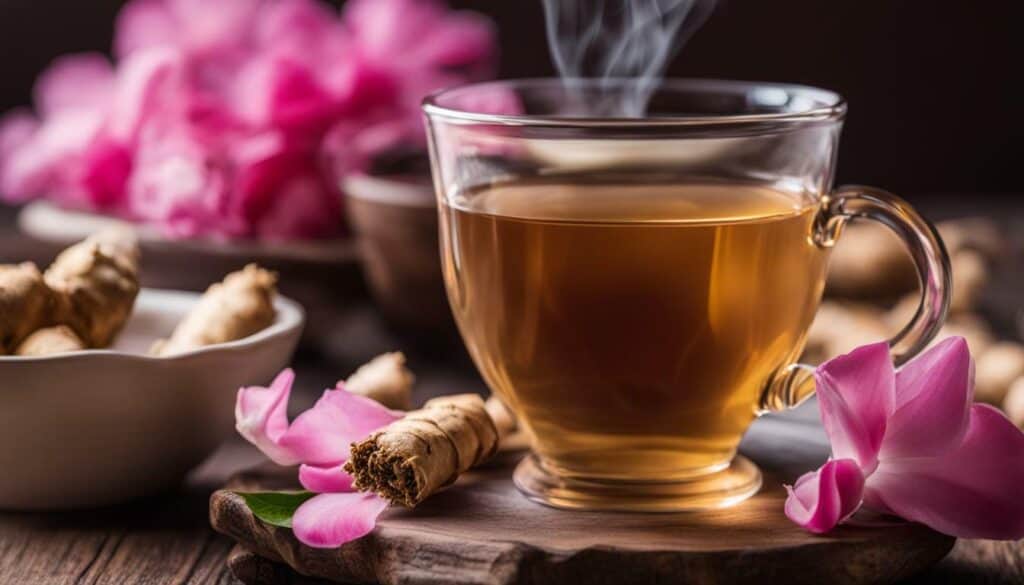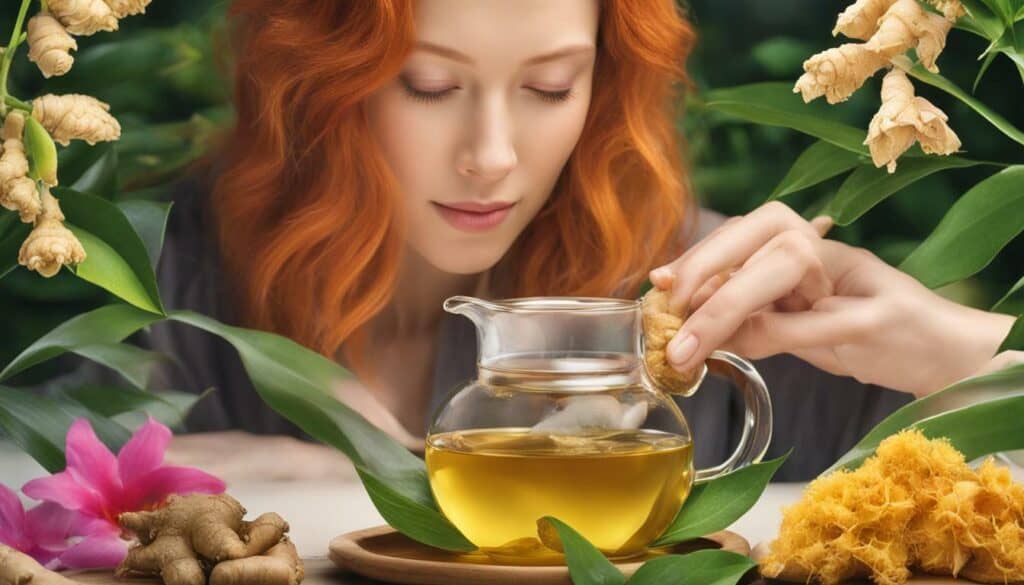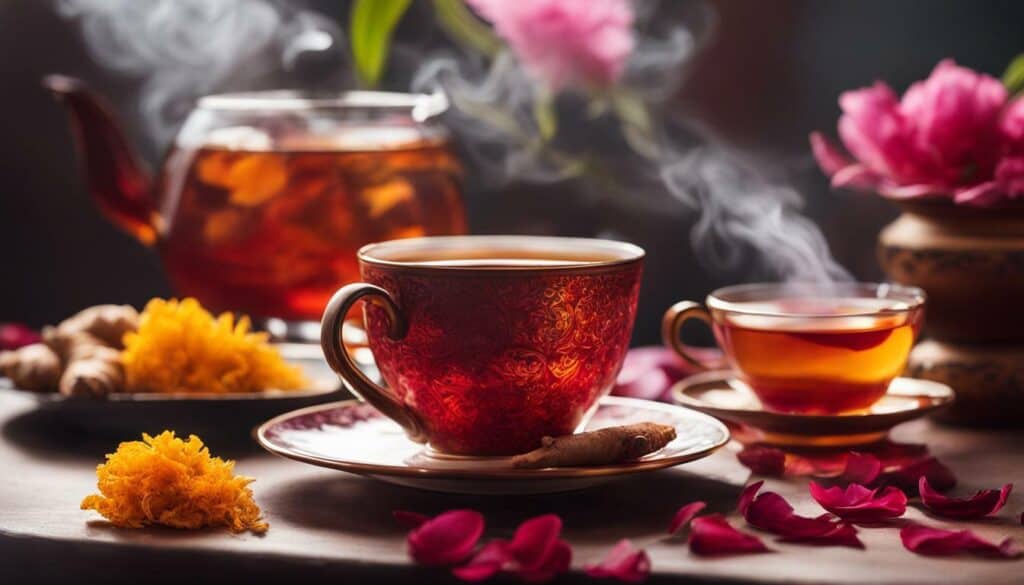The ginger flower is not only incredibly beautiful, but it also offers a range of benefits that make it worth exploring. Native to the eastern half of the United States, this plant, scientifically known as Asarum canadense, captivates with its bell-shaped flowers and intriguing story of evolution.
These flowers have an interesting adaptation – they evolved to attract small pollinating flies that emerge in early spring looking for a thawing carcass. The flower’s color resembles decomposing flesh, which helps the flies locate it. While there is some dispute over whether the flies actually pollinate the flower, they do enter it to escape the cold winds and consume the pollen, carrying some with them to the next flower.
In addition to its beauty, the ginger flower has a rich history of use. Native Americans and early settlers used it as a spice, and it can be harvested and powdered for culinary purposes. Research also validates its historical use as an antibiotic poultice for treating wounds.
But the benefits of ginger extend beyond its flower. Ginger contains gingerol, a compound with anti-inflammatory and antioxidant properties. It can aid digestion, relieve nausea, and even promote weight loss by speeding up the digestive process and promoting healthy enzymes. Ginger may also help with menstrual pain, reduce the risk of cancer, improve brain function, and fight infections. Furthermore, ginger has shown the potential to lower blood sugar and cholesterol levels, making it particularly beneficial for those with diabetes and heart disease.
Key Takeaways:
- The ginger flower is native to the eastern half of the United States and captivates with its bell-shaped flowers.
- These flowers evolved to attract small pollinating flies, although the exact role of the flies in pollination is still debated.
- Native Americans and early settlers used ginger as a spice, and it can be powdered for culinary use.
- Ginger has been used historically as an antibiotic poultice for wound treatment.
- Ginger contains gingerol, a compound with anti-inflammatory and antioxidant properties.
The Radiant Beauty of the Ginger Flower
With its captivating colors and unique shape, the ginger flower is a stunning addition to any floral arrangement. The bell-shaped flowers, ranging from deep red to pale yellow, create a vibrant and eye-catching display. Whether used in a bouquet or as a standalone centerpiece, the ginger flower adds a touch of elegance and sophistication to any occasion.
Not only does the ginger flower bring beauty to a floral arrangement, but it also carries a unique story. The flowers evolved to attract small pollinating flies that emerge in early spring, drawn by their resemblance to decomposing flesh. While it is still debated whether these flies actually pollinate the flower, they do enter it seeking refuge from the cold winds and consume its pollen, inadvertently carrying some to the next flower. This intricate relationship between the ginger flower and pollinating flies adds a fascinating layer of intrigue to its already captivating allure.
When creating a floral arrangement with ginger flowers, it is important to consider their size and structure. Their tall stems and large blooms make them ideal for creating height and drama in an arrangement. Pairing them with complementary flowers and foliage, such as roses or eucalyptus leaves, can enhance the overall aesthetic and bring out the vibrant colors of the ginger flower. Whether used in a modern or traditional arrangement, the ginger flower is sure to make a lasting impression.

The ginger flower’s unique shape and bold colors make it a versatile choice for various occasions and themes. Its vibrant hues can add a pop of color to a summer wedding bouquet or bring warmth to a fall centerpiece. The long-lasting nature of the ginger flower also ensures that arrangements maintain their beauty throughout the event.
When creating a ginger flower arrangement, consider incorporating other elements that complement its exotic appeal. Adding tropical foliage, such as palm leaves or monstera leaves, can create a lush and tropical atmosphere. For a more minimalist look, pair the ginger flowers with simple greenery and delicate filler flowers.
Incorporating ginger flowers into an arrangement allows you to unleash your creativity and experiment with different styles and textures. Whether you opt for a bold and dramatic design or a soft and romantic arrangement, the ginger flower will undoubtedly be the star, captivating all who lay eyes on it.
Unveiling the Striking Scent of the Ginger Flower
Prepare to be enchanted by the delightful scent of the ginger flower, which fills the air with its alluring fragrance. The ginger flower, also known as Asarum canadense, not only captivates with its vibrant colors but also entices with its unique aroma. As you take in the surrounding beauty, allow the scent of the ginger flower to transport you to a world of sensory delight.
This captivating fragrance is often described as a harmonious blend of spicy, floral, and citrus notes. The warm and zesty scent of ginger intermingles with the delicate sweetness of the flower, creating a captivating olfactory experience. As you inhale its scent, you may feel a sense of invigoration and relaxation simultaneously.
The scent of the ginger flower has also been associated with various symbolic meanings throughout history. In some cultures, it is believed to represent prosperity, good luck, and protection from negative energies. Its aromatic allure has made it a sought-after ingredient in perfumes, candles, and aromatherapy products, allowing its captivating scent to be enjoyed in various forms.
Overall, the ginger flower’s striking scent is a testament to its natural beauty and appeal. Whether admired in a garden or experienced through aromatic delights, its captivating fragrance adds an extra layer of enchantment to this remarkable flower.

Quotes:
“The scent of the ginger flower is like a dance of spices and florals, captivating the senses and leaving a lasting impression.” – Herbalist and Perfumer
“The unique fragrance of the ginger flower brings a sense of warmth and serenity, creating a blissful atmosphere wherever it blooms.” – Aromatherapy Expert
Table: Ginger Flower Fragrance Notes
| Note | Description |
|---|---|
| Spicy | The warm and invigorating aroma of ginger adds a spicy undertone to the overall scent profile. |
| Floral | The ginger flower’s delicate floral notes bring a touch of sweetness and elegance to the fragrance. |
| Citrus | Subtle hints of citrus add a refreshing and uplifting quality to the overall scent experience. |
Exploring the Culinary Uses of the Ginger Flower
Did you know that the ginger flower can be used as a flavorful ingredient in various recipes? While most people are familiar with ginger root, the flower of the ginger plant is a hidden treasure in the culinary world. With its unique taste and aroma, the ginger flower adds a delightful twist to dishes, turning ordinary meals into extraordinary culinary experiences.
One popular way to incorporate the ginger flower into recipes is by using it as a garnish. Its vibrant colors and delicate petals make it a visually appealing addition to salads, desserts, and even cocktails. The flower’s subtle spiciness adds a touch of warmth and complexity to any dish, enhancing the overall flavor profile.
Beyond its decorative use, the ginger flower can also be used as a key ingredient in cooking. Its aromatic qualities make it an excellent choice for infusing oils, vinegars, and syrups. By steeping the flower in these liquids, you can extract its unique flavors and create a versatile culinary base for a variety of recipes.
| Recipes | Ingredients |
|---|---|
| Ginger Flower Stir-Fry | – Ginger flower – Assorted vegetables – Soy sauce – Garlic – Sesame oil |
| Ginger Flower Infused Vinegar | – Ginger flower – White vinegar – Honey – Peppercorns |
| Ginger Flower Mango Salad | – Ginger flower – Ripe mangoes – Red onions – Lime juice – Cilantro |
With its versatility and unique flavor, the ginger flower opens up a world of culinary possibilities. Whether you choose to use it as a garnish or as a key ingredient, its presence will surely elevate your dishes to new heights. So, why not embark on a culinary adventure and explore the beauty and taste of the ginger flower?

For centuries, the ginger flower has been recognized for its healing abilities and has been used as a poultice to treat wounds. Native Americans and early settlers discovered the medicinal properties of this remarkable flower and utilized it for its antibacterial and anti-inflammatory effects. The ginger flower poultice, made by grinding the flower into a fine paste and applying it directly to the affected area, was known to promote wound healing and reduce pain.
Research has shown that the ginger flower poultice possesses powerful antibiotic properties, validating its historical use as a natural remedy for skin infections and injuries. Its ability to inhibit the growth of harmful bacteria and reduce inflammation makes it a valuable treatment option for various skin conditions.
Not only does the ginger flower offer healing benefits externally, but ginger as a whole has been used for its numerous health benefits. The flower’s rich source of gingerol, a compound with potent anti-inflammatory and antioxidant properties, contributes to its therapeutic effects. Ginger has been widely recognized for its ability to aid digestion, alleviate nausea, and promote weight loss by boosting metabolism.
Ginger also has the potential to improve brain function, reduce cancer risk, and fight infections. Furthermore, studies have shown that ginger can lower blood sugar and cholesterol levels, making it a valuable addition to the daily routine of those managing diabetes or heart disease. The ginger flower and its related plant have become increasingly popular as natural remedies due to their remarkable health benefits.
Harnessing the Health Benefits of Ginger
Ginger, the main ingredient derived from the ginger flower, is renowned for its numerous health benefits. It contains gingerol, a compound with powerful anti-inflammatory and antioxidant properties that can have a positive impact on overall well-being.
One of the key benefits of ginger is its ability to aid digestion. It stimulates the production of digestive enzymes, which helps to break down food more efficiently and can relieve common digestive issues such as bloating and indigestion. Incorporating ginger into your diet, either through ginger tea or adding it to meals, can help to support a healthy digestive system.
Another remarkable benefit of ginger is its potential to relieve nausea. Whether you’re experiencing motion sickness, morning sickness during pregnancy, or general nausea, ginger has been shown to be effective in reducing these symptoms. It acts directly on the digestive system, calming it and reducing the feeling of queasiness.
Ginger’s impact on weight loss is another aspect of its health benefits. By increasing the body’s metabolic rate and promoting the production of heat, ginger can help to burn calories more efficiently. Additionally, ginger has been found to suppress appetite, leading to reduced food cravings and aiding in weight management.

| Health Benefits of Ginger | Uses |
|---|---|
| Relieves digestive issues | Incorporate ginger into meals or drink ginger tea to support a healthy digestive system |
| Reduces nausea | Consume ginger to alleviate motion sickness, morning sickness, or general nausea |
| Aids in weight loss | Increase metabolism and suppress appetite with ginger to support weight management |
How to Make Ginger Flower Tea
- Peel and slice fresh ginger root into thin pieces.
- Bring a pot of water to a boil.
- Add the ginger slices to the boiling water and let it simmer for about 10-15 minutes.
- Remove from heat and strain the ginger tea into a cup.
- You can add honey or lemon for added flavor, if desired.
- Sip and enjoy the refreshing and health-boosting properties of ginger flower tea.
Ginger’s Potential to Improve Overall Health
Beyond its culinary uses, ginger has the potential to significantly improve various aspects of your overall health. This versatile root has been used for centuries in traditional medicine for its powerful healing properties. From aiding digestion to reducing inflammation, ginger offers a range of health benefits that make it a valuable addition to your wellness routine.
- Digestive Aid: Ginger has long been recognized for its ability to soothe digestive issues. It can help alleviate symptoms of indigestion, such as bloating, gas, and stomach discomfort. Additionally, ginger can stimulate the production of digestive enzymes, aiding in the breakdown and absorption of nutrients.
- Anti-Inflammatory Properties: Ginger contains gingerol, a potent compound with anti-inflammatory effects. Regular consumption of ginger can help reduce inflammation in the body, which is linked to various chronic conditions like arthritis, heart disease, and certain types of cancer.
- Immune Booster: Ginger has natural immune-boosting properties, thanks to its antioxidant content. Antioxidants help protect the body against free radicals and oxidative stress, supporting a healthy immune system and reducing the risk of infections.
Discover the Healing Powers of Ginger
“Let food be thy medicine and medicine be thy food.” – Hippocrates
Ginger’s health benefits extend beyond digestion and inflammation. Research suggests that ginger may also have a positive impact on brain function, helping enhance cognitive abilities and memory. Additionally, ginger has been shown to have potential anticancer properties, inhibiting the growth of cancer cells and reducing the risk of certain cancers.
One of the remarkable aspects of ginger is its ability to lower blood sugar levels and cholesterol. This makes it especially beneficial for individuals with diabetes and heart disease. Ginger can help regulate blood sugar levels, potentially reducing the need for insulin or other medications. Moreover, it can help improve cholesterol profiles by lowering LDL (bad) cholesterol and increasing HDL (good) cholesterol.
Incorporating ginger into your daily routine is simple. You can enjoy it in various forms, including fresh ginger root, ginger tea, or adding it as a spice to your favorite recipes. Embrace the natural healing powers of ginger and experience the transformative impact it can have on your overall health.

With its numerous health benefits, you may want to consider incorporating ginger plants into your own garden. Ginger, a root known for its distinct flavor and aroma, has been used for centuries as a natural remedy for various ailments. Not only does it add a unique touch to culinary creations, but it also offers a range of medicinal properties that can support overall well-being.
The ginger plant, scientifically known as Zingiber officinale, contains bioactive compounds that have been studied for their potential health benefits. One of the key compounds found in ginger is gingerol, which possesses powerful anti-inflammatory and antioxidant properties. These properties make ginger an effective remedy for soothing digestive issues, reducing inflammation, and boosting the immune system.
Research suggests that ginger may help alleviate nausea and vomiting, making it a popular choice for those experiencing motion sickness or morning sickness during pregnancy. It can also aid in digestion by promoting the production of digestive enzymes and increasing the speed at which food moves through the digestive tract. Additionally, ginger has been shown to have pain-relieving properties and may help reduce muscle soreness and menstrual pain.
When incorporating ginger into your garden, it is important to provide the plant with well-drained soil and partial sunlight. Ginger plants thrive in warm and humid environments, so it is essential to mimic these conditions when growing them. Harvesting ginger is relatively simple – once the plant reaches maturity, you can dig up the rhizomes, which are the underground stems, and use them fresh or dry them for later use. Whether consumed as a tea, added to recipes, or used topically as a poultice, ginger can be a valuable addition to your natural remedy arsenal.
| Benefits of Ginger as a Natural Remedy | |
|---|---|
| Gingerol | Anti-inflammatory and antioxidant properties |
| Relieves Nausea and Vomiting | Effective remedy for motion sickness and morning sickness |
| Aids Digestion | Promotes the production of digestive enzymes and facilitates digestion |
| Reduces Pain | May help alleviate muscle soreness and menstrual pain |
Whether you’re seeking relief from digestive discomfort, looking to soothe aches and pains, or simply want to enhance your culinary creations, ginger can be a versatile and effective natural remedy. By growing your own ginger plants, you can have a constant supply of this beneficial root readily available in your own backyard.

Ginger possesses the remarkable ability to regulate blood sugar and cholesterol levels, making it a valuable addition to a healthy lifestyle. Studies have shown that ginger can effectively lower fasting blood sugar levels and improve insulin sensitivity in individuals with type 2 diabetes. This is attributed to the active compounds in ginger, such as gingerol, which have anti-inflammatory and antioxidant properties that help alleviate oxidative stress and inflammation commonly associated with high blood sugar.
Furthermore, ginger has been found to have cholesterol-lowering effects. It can help reduce levels of total cholesterol, LDL (bad) cholesterol, and triglycerides, while increasing HDL (good) cholesterol. This can significantly reduce the risk of heart disease and other cardiovascular complications.
Adding ginger to your diet is easy and versatile. You can incorporate it into your meals by grating or slicing fresh ginger and adding it to stir-fries, soups, or marinades. Alternatively, you can enjoy it as a warm and soothing ginger tea. To make ginger tea, simply steep a few slices of fresh ginger in hot water for about 10 minutes and enjoy the fragrant and invigorating beverage.
It’s important to note that while ginger can provide notable benefits in blood sugar and cholesterol regulation, it should not be used as a substitute for medical treatments or prescribed medications. Always consult with a healthcare professional before making any significant changes to your diet or treatment plan.

In summary, ginger and its flower offer a variety of health benefits, including their impact on blood sugar and cholesterol levels. By incorporating ginger into your diet, you can potentially improve your overall health and reduce the risk of chronic conditions. So why not add a touch of ginger to your meals or indulge in a cup of ginger tea today?
Ginger Flower – A Fountain of Wellness
From its splendid beauty to its numerous health benefits, the ginger flower truly embodies a fountain of wellness. Native to the eastern half of the United States, this bell-shaped flower, scientifically known as Asarum canadense, has a captivating story behind its evolution. It has evolved to attract small pollinating flies that emerge in early spring, looking for a thawing carcass. The flower’s color, resembling decomposing flesh, helps the flies locate it. While there is some dispute over whether the flies actually pollinate the flower, they do enter it to escape the cold winds and consume the pollen, inadvertently carrying some with them to the next flower.
But the beauty of the ginger flower is not just skin-deep. It offers a wealth of benefits for both culinary and medicinal purposes. For centuries, Native Americans and early settlers used it as a spice, and it can still be harvested and powdered today. Additionally, the ginger flower has been utilized as a poultice to treat wounds. Research validates its historical use as an antibiotic, showcasing its therapeutic potential.
However, the wellness benefits of ginger extend far beyond its flower alone. Ginger contains an active compound called gingerol, known for its anti-inflammatory and antioxidant properties. This amazing spice can aid digestion, alleviate nausea, and promote weight loss by speeding up the digestive process and supporting healthy enzymes. Furthermore, ginger may assist with menstrual pain, reduce the risk of certain cancers, improve brain function, and even help fight infections. People with diabetes and heart disease can also benefit from ginger, as it has shown the ability to lower blood sugar and cholesterol levels.
In conclusion, the ginger flower is not only a visually stunning plant but also a source of diverse benefits for our well-being. From its rich history to its culinary uses and medicinal properties, the ginger flower and its versatile ginger root counterpart have a rightful place in our wellness routines. Whether enjoyed in a fragrant cup of ginger tea or incorporated into delectable dishes, this remarkable flower truly reigns as a fountain of wellness.
Conclusion
In conclusion, the ginger flower is not only a visually stunning plant, but it also offers a myriad of health benefits, making it a truly remarkable addition to your life.
The ginger flower, also known as Asarum canadense, can be found in the eastern half of the United States. Its bell-shaped flowers, although initially unappealing to some, have evolved to attract small pollinating flies. While the exact role of these flies in pollination is still debated, they do enter the flower to consume pollen, potentially aiding in the plant’s reproductive cycle.
Not only is the ginger flower beautiful, but it is also versatile. Native Americans and early settlers used it as a spice, and it can be harvested and powdered for culinary purposes. Additionally, the flower has been used as a poultice to treat wounds, with scientific research supporting its historical use as an antibiotic.
Furthermore, ginger itself possesses a wide range of health benefits. It contains gingerol, a compound known for its anti-inflammatory and antioxidant properties. Ginger can aid in digestion, alleviate nausea, and promote weight loss by aiding in the digestive process and boosting enzyme activity. It may also help reduce menstrual pain, lower the risk of certain types of cancer, improve brain function, and combat infections. Additionally, ginger has the potential to lower blood sugar and cholesterol levels, making it beneficial for individuals with diabetes and heart disease.
With its captivating beauty and remarkable health benefits, the ginger flower is an exceptional addition to any garden or lifestyle. Whether used in culinary creations or as a natural remedy, this versatile plant is sure to bring joy and wellness into your life.
FAQ
Q: What is the ginger flower?
A: The ginger flower, scientifically known as Asarum canadense, is a plant found in the eastern half of the United States.
Q: How did the ginger flower evolve?
A: The ginger flower evolved to attract small pollinating flies that emerge in early spring looking for a thawing carcass. Its color resembles decomposing flesh, which helps the flies locate it.
Q: Do the flies actually pollinate the ginger flower?
A: There is some dispute over whether the flies actually pollinate the flower, but they do enter it to escape the cold winds and consume the pollen, carrying some with them to the next flower.
Q: What are the benefits of the ginger flower?
A: The ginger flower has several benefits. It can be used as a spice, harvested and powdered for culinary use. It has also been used as a poultice to treat wounds, with research validating its historical use as an antibiotic.
Q: What are the health benefits of ginger?
A: Ginger contains gingerol, a compound with anti-inflammatory and antioxidant properties. It can aid digestion, relieve nausea, promote weight loss, help with menstrual pain, reduce cancer risk, improve brain function, fight infections, lower blood sugar, and cholesterol levels.
Q: Can ginger be used as a natural remedy?
A: Yes, ginger is often used as a natural remedy for various ailments. It can be consumed as tea, used in recipes, or even cultivated as a plant.
Q: How does ginger benefit those with diabetes and heart disease?
A: Ginger can lower blood sugar and cholesterol levels, making it beneficial for those with diabetes and heart disease.
Q: What are the overall wellness benefits of the ginger flower?
A: The ginger flower is not only beautiful but also offers a range of benefits for both culinary and medicinal purposes.
Is Vegan Foie Gras a Healthier Alternative to Traditional Foie Gras?
Many argue that vegan foie gras presents a healthier option compared to traditional foie gras. By replacing animal fat with plant-based ingredients, vegan foie gras eliminates the health risks associated with excessive saturated fat intake. However, it is important to note that vegan foie gras should still be consumed in moderation, as dietary balance is crucial for overall health.







Leave a Reply